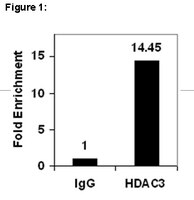17-10238 Sigma-AldrichChIPAb+™ HDAC3 Antibody
This ChIPAb+ HDAC3 -ChIP Validated Antibody & Primer Set conveniently includes the antibody & the specific control PCR primers.
More>> This ChIPAb+ HDAC3 -ChIP Validated Antibody & Primer Set conveniently includes the antibody & the specific control PCR primers. Less<<Recommended Products
Overview
| Replacement Information |
|---|
Key Specifications Table
| Species Reactivity | Key Applications |
|---|---|
| B, H, Ht, M | WB, ChIP |
| References |
|---|
| Product Information | |
|---|---|
| Format | Purified |
| Control |
|
| Presentation | Anti-HDAC3 (mouse monoclonal). One vial containing 100 µg of protein G purified monoclonal in buffer containing 0.02 M phosphate buffer (pH7.6), 0.25M NaCl, 0.1% sodium azide and 30% glycerol. Store at -20°C. Concentration: 1 mg/mL Normal Mouse IgG. One vial containing 125 µg of purified mouse IgG in 125 µL of storage buffer containing 0.1% sodium azide. Store at -20°C. ChIP Primers, p21. One vial containing 75 μL of each primer (5 μM) specific for a region of the human p21 (WAF1/CIP1/CDKN1A) promoter. Store at -20°C. FOR: CCC ACA GCA GAG GAG AAA GAA REV: CTG GAA ATC TCT GCC CAG ACA |
| Quality Level | MQ100 |
| Physicochemical Information |
|---|
| Dimensions |
|---|
| Materials Information |
|---|
| Toxicological Information |
|---|
| Safety Information according to GHS |
|---|
| Safety Information |
|---|
| Packaging Information | |
|---|---|
| Material Size | 25 assays |
| Material Package | 25 assays per set. Recommended use: 4 μg of antibody per chromatin immunoprecipitation (dependent upon biological context). |
| Transport Information |
|---|
| Supplemental Information |
|---|
| Specifications |
|---|
| Global Trade Item Number | |
|---|---|
| Catalog Number | GTIN |
| 17-10238 | 04053252639678 |
Documentation
ChIPAb+™ HDAC3 Antibody Certificates of Analysis
| Title | Lot Number |
|---|---|
| ChIPAb+ HDAC3 - 2028594 | 2028594 |
| ChIPAb+ HDAC3 - Q1957677 | Q1957677 |
| ChIPAb+ HDAC3 - 2562395 | 2562395 |
| ChIPAb+ HDAC3 - 3188916 | 3188916 |
| ChIPAb+ HDAC3 - 3326882 | 3326882 |
| ChIPAb+ HDAC3 - 3769853 | 3769853 |
| ChIPAb+ HDAC3 - 4007581 | 4007581 |
| ChIPAb+ HDAC3 -2619702 | 2619702 |
| ChIPAb+ HDAC3 -2673167 | 2673167 |
| ChIPAb+ HDAC3 -2702123 | 2702123 |
Brochure
| Title |
|---|
| Advance your Epigenetics Research |









